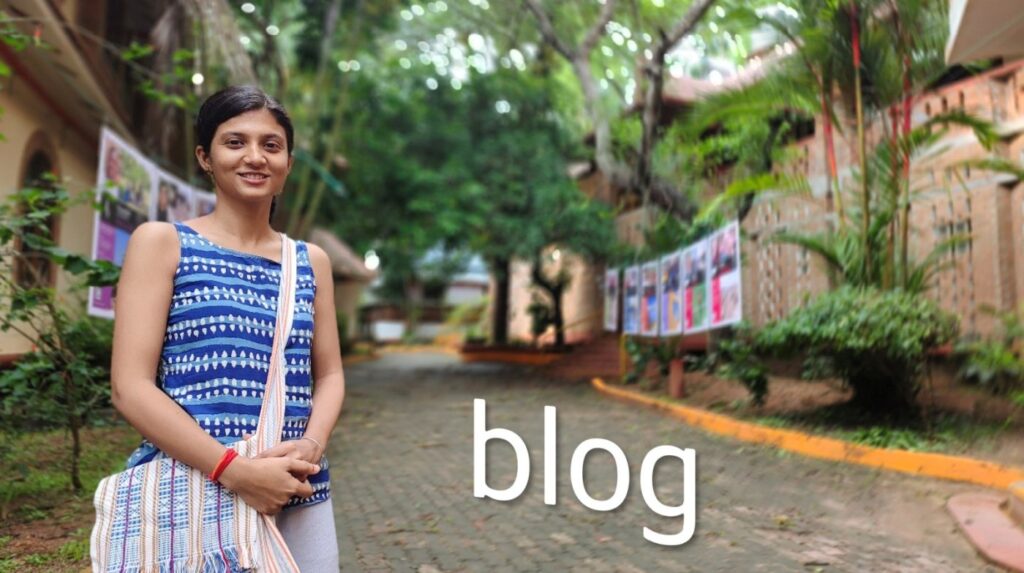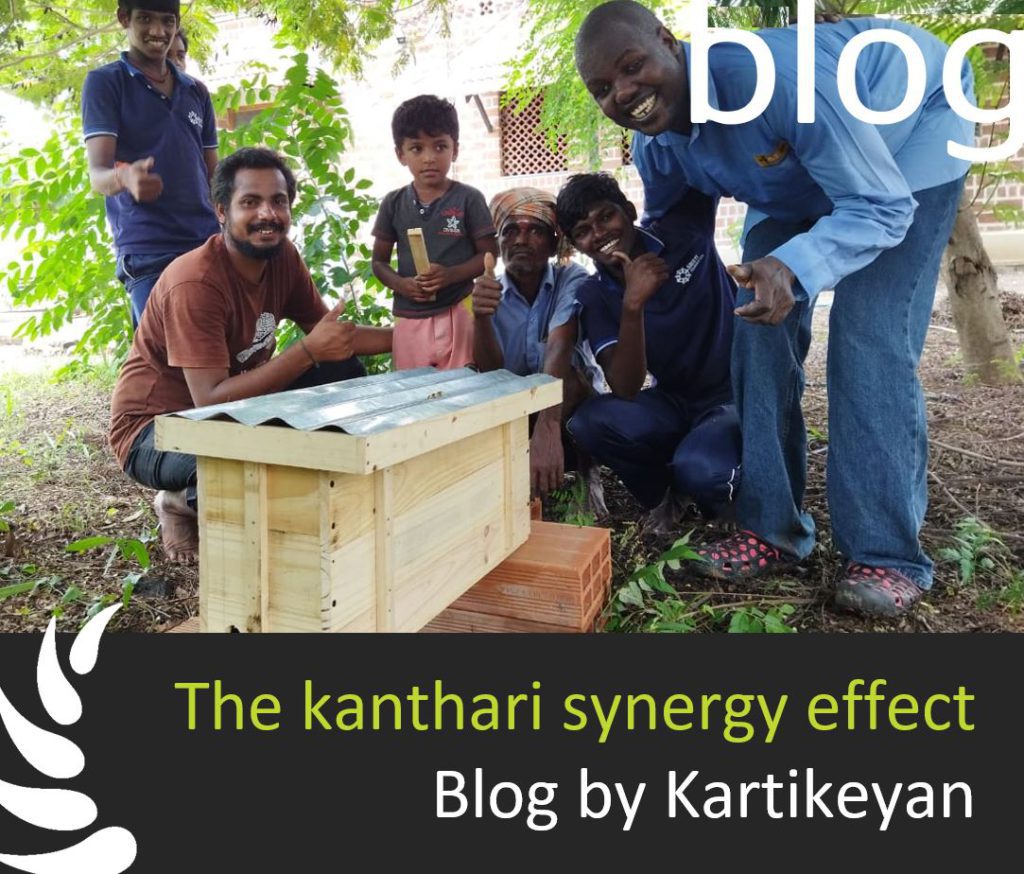Akanksha always enjoyed the process of creating from scratch. She believes that working with artisans and embracing the basic principles of zero waste can significantly reduce waste generation, thereby addressing the root cause of environmental pollution. She started her project Baatooni Rang (talking colors) in August 2017. To learn more about what motivates Akanksha to make a difference in the artisans community.
by Akanksha Priya
A Connection to Craft
‘Wait, Wait!’
‘Look at this!’
‘I made this seven years ago!’
Savitri had joy in her eyes while she was pulling a piece of hand-embroidered fabric from the pile kept in the inventory!
‘This is so beautiful!’ – I said with a smile. Although, I was wondering what made it be decked in the unsold pile kept in the inventory.
‘You have been working for so long!’ – I said
‘See, this one, I made this too. You know I was quite young at that time!’
She had a smile on her face. She was continuously gazing at the embroidered piece.
She began in a low voice – ‘I had started working here when this organization came into existence! I have made so many pieces of narrative scrolls, sarees, dupattas, bags, fabric dolls, cushion covers, and many more products.’
‘Many designers came here and I make sure that I show my previous works to each of them!
So how do you find my work?’
It was my 2nd week working in the NGO. I have always wanted to work with the handicrafts of my state. I had very thoughtfully chosen to work with the artisans. I have always felt a connection with traditionally handcrafted products.
I was speechless. Each of her works was so intricate and full of colored fabric patches. She was so deeply involved in her craft of Sujni that one could make out her work reflected a part of her soul. I felt a twitch in my eyes.
The Silent Artisans
Savitri is a 58-year-old woman, but she looks 70. She moves so softly that one can hardly hear her walking! She is lean and thin and is always found in her chair working silently;
She chooses a corner near the common working table where other women are found to be chit-chatting while working. Savitri is someone who chooses to be least interactive with the group.
If I might guess, this could be because she is the senior artisan working here! And she has no colleagues left here who had joined the NGO with her. Some chose to stay back at home without work!
This NGO has a continuous inflow & outflow of artisans. Mostly young women from families who face financial challenges are found to be working here!
So, what could be the reason?
I was thinking about this when suddenly I felt someone’s hand on my shoulder. While I was lost in all these questions, I almost forgot to respond to Savitri.
‘What is it that you are thinking about?’- Savitri Ji smiled and said- ‘How do you find my work?’
The Unseen Struggles
I suddenly came out of my thought bubble and politely said, ‘All the scrolls are exceptionally beautiful, Savitri ji!’
‘You are so talented!’
‘Your work stands out!’
‘I felt like I was witnessing a Textile art exhibition where each of your works narrates its journey of excellence and intrinsic craft of Sujni.’
‘Then, give me new designs to work on; I can work with a good finish as you find in these works here!’ – said Savitri.
She was continuously looking into my eyes as if she was trying to tell me how passionate she was about her work! Soon she left the inventory and returned to her chair.
I too returned to my desk and was thinking about Savitri. I could notice her sitting in the chair and hand-stitching.
‘It is a tedious job! I wonder if they are paid well.’ I was murmuring to myself!
‘No! they are not… Not at all
– a voice interrupted me.
I looked back and found Guddi ji!
She is also an artisan who has been working for the past two years.
‘She is only paid six thousand rupees for a month while she has been working in this NGO for the last 10 years!’
Moreover, like every one of us, she too is expected to work overtime whenever needed! Director Madam always tells her that she is too slow in her work!’
‘What, too slow! She is doing the most intricate motifs- hand stitching small motifs which of course takes time. Director Madam needs to learn the craft first before commenting on her pace!’ – I spoke almost biting my lips.
Guddi continued- ‘And, you know, here most of us are paid on piece per pay, that comes to INR 4000 per month!’
‘For the past two years, I have contributed to tailoring work along with Sujni and also made all the emergency work pieces! Then also, I haven’t got any bonus or increased my wage!’
‘You see I will also leave this NGO soon!’- said Guddi.
By this time, I had already started with the mental math for these numbers!
This was the year 2018 when Savitri was getting INR 6000 per month after serving for 10 continuous years. This implies that for her work 30 days a month with 8-9 hours each day, she is rewarded with approximately INR 22 per hour!
Similarly, for Guddi who is working for two years gets INR 4000, which is estimated to be INR 15 per hour of work!
But the handcrafted products are priced at a high margin in the market?
For example, if we buy a handcrafted saree priced at INR 6000/- that is worked on by the artisan for 25-30 hours (3 working days) will fetch around INR 450 – 660 for this saree.
This is crazy! This is the exploitation of our artisans! Where does this money go? if not the artisans! This really came to me as a shock! These are the pillars of our rich handicrafts and preservers of our culture; And, this is what they are being provided with!
Guddi observed a pause and said again-
‘One more thing, do you know why Sarita is not showing up for the past four days?
She had taken back to full-time household work rather than feeling undervalued and underpaid for her work.’
A Legacy of Craftsmanship
I rested my head on the table! At this time, I could only think of my grandmother!
It was the year 1999 when I was around 6 years old! She had gifted two hand-sewn quilts for our home. She had hand embroidered it with old cotton threads that were pulled from old sarees. She had taken almost one year to complete the two of them. And they were so intricate.
I did not quite understand back then about Sujni. This is quite an old technique where women made embroidered quilts using old sarees and dhotis. The layers of fabric were secured with running stitches. Also, they were decorated with motifs detailed with colored threads.

Reflecting on Cultural Heritage
These colored threads were dyed in natural pigments from flowers, leaves, and earth minerals. Sadly, what we are left with today are acrylic colors and synthetic dyes. The care for the environment is no more seen now.
We have such a rich beautiful and old culture, and if nothing is done, we will lose skills and methods. It was a practice a long time ago when the mothers handstitched quilts for their daughters. They gifted them these beautiful Sujni quilts at the time of marriage for the daughters to start a new life in the in-laws’ house.
Reflecting on the cultural aspect, I can connect to the craft now! But how much is it worth?
The Value of Artisanship
People spend their money buying craft products. But each artisan deserves respect, a fair price for their work, and praises for themselves.
I could visualize my grandmother’s eyes. It must have hurt her so much to stitch the tiny pieces of fabric with sharp needles. Her fingers must have been hurt while she passed the needle through multiple layers of fabric. What goes into the making of the craft is the actual journey of it!
I was deeply grieved and was soon clouded by many, many questions.
The Artisan’s Dilemma
Savitri.
Guddi.
Savita.
Three women artisans! What makes them different and yet similar?
To choose one’s craft over unjust remuneration!
Or
To continuously fight for one’s rights without giving up on the craft
Or
To sacrifice one’s passion for craft and accept it as her fate!
Whatsoever the situation be, the truth is that the craftspeople are suffering and so is the craft!
I must save the craftswomen to save the craft and its beauty! I lifted my head and said to myself- ‘I must do something soon.’
‘The makers of the craft products earn less than 10 percent of the product’s price. And most of us are not aware of this!’
‘The NGOs and brands who are selling their craft products must practice price transparency, by sharing the price breakdown of each product. This would let the customers/clients know if their money is going to the artisans and help them make an informed decision.’
I see a silver lining behind the grey clouds!
Akanksha’s project creates sustainable merchandise from Indian tribal and folk paintings, embroidery and textiles, which tell a cultural or historical narrative of places that tourists visit. The key focus is on handmade products by local artisans, following a zero-waste production cycle. These artisans have long championed the use of natural resources in a sustainable manner, adhering to a zero-waste philosophy.
By supporting and promoting their craft, Akanksha hopes to reshape the consumer mindset, and promote conscious, sustainable purchasing habits.
Do you, like Akanksha carry a plan to start your own impact making organisation? And are you looking for a place to acquire the right tools and skills? Then visit the following website and apply today to become a participant in the next course that starts in April 2024: www.kanthari.org
You can also check out kanthari TALKS to learn more about previous kanthari participants.



